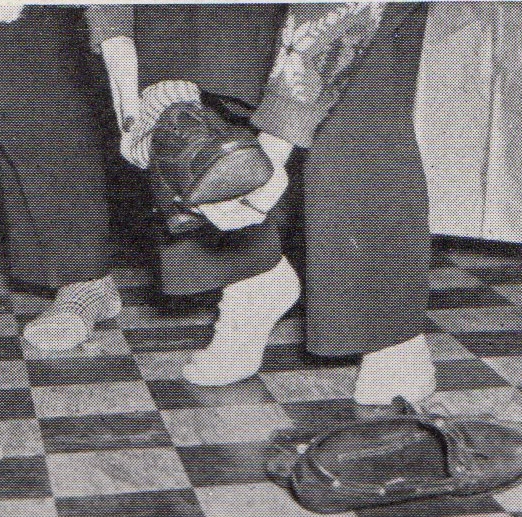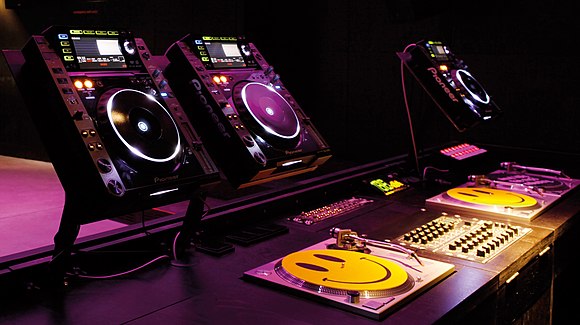From the blog: History of the DJ from Minnesota’s Favorite DJs or continue reading below.
The role of the DJ (Disc Jockey) has a long and varied history. Ever since the invention of recorded music and more importantly, the invention of broadcasting over the radio, the DJ has evolved to become what we now know today as the Modern DJ.
1935 - The term "Disc Jockey" is invented
Walter Winchell was an American radio commentator who coined the term "disc jockey".
At the time, the term disc was in reference to the disc-shaped phonograph records.
While jockey, simply referenced the operator of a machine.
The term disc jockey was used to describe Walter's colleague and fellow radio announcer Martin Block, who gained widespread fame for being the first to play popular recorded music over the radio.

1943 - The first DJ Dance Party
It's reported that the worlds first "DJ Dance Party" was held in the upstairs function room of the Loyal Order of Ancient Shepherds in Otley, England.
At this party, radio DJ Jimmy Savile played jazz records for the crowd.
Later, in 1947, Jimmy claims to have been the first DJ to use twin turntables to be able to continuously play music.
This claim however is untrue, since twin turntables were illustrated in the BBC Handbook as early as 1929 and were advertised for sale in Gramophone Magazine in 1931.
1950s - The Rise of the Sock Hops
As the world turned and entered the 1950s, American radio DJs began performing as human jukeboxes at sock hops and "platter parties".
The popularity of 45-rpm records with hit singles meant that they could go back and forth from song to song.
One particular "sock hop" DJ was Bob Casey, who brought the two-turntable system to the United States.
As things progressed, promoters, who called themselves DJs, would throw large dance parties centered around the disc jockey.
These DJs had large, loud PA speaker systems to play popular dance music, and the parties became quite profitable by charging for admission.

1960s and 1970s
The late 1960s saw the advent of nightclubs and discothèques grow around the world, but predominantly in Europe and the United States.
DJ equipment progressed as specialized audio equipment was made for the sole purpose of mixing different audio sources together.
By 1969, DJ Francis Grasso made beatmatching popular in New York at the Sanctuary nightclub.
What is Beatmixing?
Beatmixing, or beatmatching, is the technique used by DJs to create a seamless transition between records. This is done by "matching beats", or tempos.
In 1972, the company Technics released the first SL-1200 turntable, which later evolved into the SL-1200 MK2 in 1979.
This turntable remains an industry standard of DJing, with DJs today (in the 2020s) seeking out a pair of "1200s" for use with more contemporary "Digital DJing".
In the mid 1970s, a genre of music we now know as Disco became extremely popular. It was a soul-funk blend of dance music and in its purest form, was music made for dancing.
Nightclubs experienced a revival with the new Disco music, and companies formed record pools, or curated collections of music, for DJs to gain access to newer industry music faster.
Hip-hop DJ Grand Wizard Theodore invented the scratching technique in 1975, and the rise of hip-hop continued with Sugar Hill Gang's "Rapper's Delight" being released in 1979.
https://www.youtube.com/watch?v=mcCK99wHrk0
1980s - The Music Television Generation
When MTV "Music Television" launched on cable TV networks in 1981, a new spin on the disc jockey was born: the video jockey.
Popular VJs Mark goodma, Martha Quinn, and Nina Blackwood hit the scene, and Martha Quinn was named "MTV's Best-Ever VJ" in Rolling Stone Magazine.
Some say the popularity of music videos was the downfall of Disco music.
By the mid 1980s, technology kept progressing with the rise of synthesizers and audio processors, and "techno" music was born.
Originating in the Detroit club scene, techno distanced itself from Disco's roots and focused almost entirely on the synthesized beats of pure electronic music.
The electronic beats and drum machines worked their ways into other genres of music, and hip-hop crossed over and blended with other genres with the likes of "Walk this Way", a collaboration between Run DMC and Aerosmith.
The end of the 80s saw the rise of DJ Times Magazine, one of the first US-based magazines specifically targeted towards professional and mobile DJs.
1990s - Rise of the Mobile DJ
The 1990s saw a massive shift and expansion of music genres. And in 1991, Mobile Beat magazine came out, specifically targeting mobile DJs.
What is a Mobile DJ?
A mobile DJ is a professional DJ who travels and brings along all of the necessary equipment to play the music for the event. They bring the required music library, music players, and audio mixing equipment, along with the amplification and PA speakers for the intended crowd and audience.

As technology advanced past the vinyl records to cassette tapes, and compact discs (CDs), mobile DJs evolved as well.
Denon DJ produced the first CDJ in 1993. It was a 2-piece rackmounted dual-deck variable-pitch CD-Player with jog wheel and instant cue buttons for DJs.
The ability for the mobile DJ to have massive music libraries at their fingertips with compact discs, and instantly start/stop tracks without having to seek and find them was huge.
CDJs gave disc jockeys the ability to mix music on CDs just like they used to be able to do on turn tables with vinyl records.
In 1998, the first MP3 digital audio player was released, and computer software was developed to allow DJs to use something called a "Digital Control Disc" to be able to control MP3 digital music playback through their CDJ equipment.
The first DJ software "Final Scratch" was developed by N2IT.
2000s - Rise of the Digital DJ
With the release of iTunes by Apple in 2001, that marked the turning point for digital music.
As MP3s, AACs, and other digital audio formats becoming increasingly popular, record labels started releasing music digitally in addition to the standard compact-disc albums & singles.
The easier access to digital music led to more software platforms to mix and play music.
The DJ software "Final Scratch" was bought by Native Instruments in 2002 and became the basis for Traktor Scratch software.
Serato is another DJ software company that started in 1998 and gained popularity through the 2000s with its software "Scratch Studio"
In July of 2003, VirtualDJ was released as the successor to AtomixMP3, and went on to win the prize for best mixing software at the 25th edition of the Annual International Dance Music Awards in Miami.
2010s - Mainstream DJs
With the rise of streaming platforms for independent artists and performers to distribute their music, platforms such as SoundCloud gave DJs more opportunities to join the mainstream.
Electronic dance music (EDM) gained significant popularity with the rise of subgenres such as Dubstep, and pop music superstars relied on electronic beats to create their top-40 hits.
Artists and groups like The Black Eyed Peas, and Lady Gaga brought EDM influenced dance music to pop radio, while groups like LMFAO made DJing extremely mainstream. (Redfoo from LMFAO got his start as a mobile DJ)
Entire music festivals were born focused on DJs and producers of electronic music, such as Coachella and Lollapalooza.
2020s - The Modern Mobile DJ
The pandemic of 2020 shut down almost all live and in-person events, and saw a rise in DJs performing on live streams on platforms like Twitch.
DJ equipment manufacturers were plagued by supply chain constraints due to the shutdowns and issues shipping overseas.
Many popular DJ equipment models were discontinued, while other manufacturers rose to take their place, with a new focus on digital performance and streaming.
With popular communities on Reddit focusing on becoming a beginner DJ, its easier than ever for someone with an interest in music to learn how to mix.
Many DJs have produced tutorials available on YouTube, and the proliferation of content on social media has made it easier than ever for independent DJs to reach a large audience.
Modern mobile DJs who serve contemporary clients for events such as weddings and school dances have more tools at their disposal now than ever.
The ability to use a streaming platform to instantly get a song request, or the ability to leverage incredibly powerful DJ software to beatmix and do live-mashups easier than ever, means that it is the DJs role to read the crowd and deliver the right song in the right way.
Now, more than ever, are professional mobile DJs required to have a greater skillset and take on more responsibilities at events.
The tools we have at our disposal means we can do more, with less.
We are excited to see where technology and music takes us into the future!
Original post here: History of the DJ
No comments:
Post a Comment